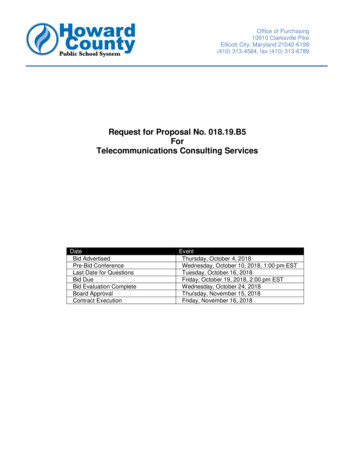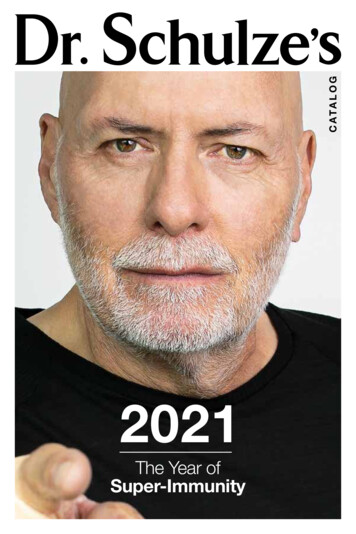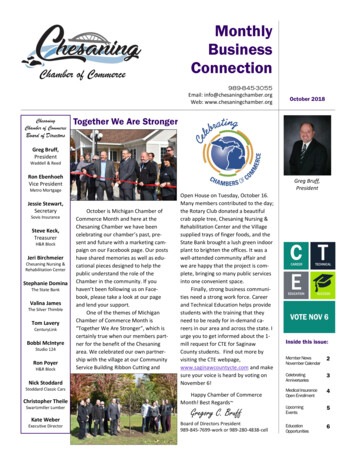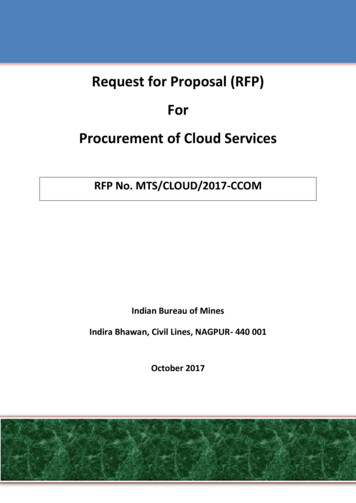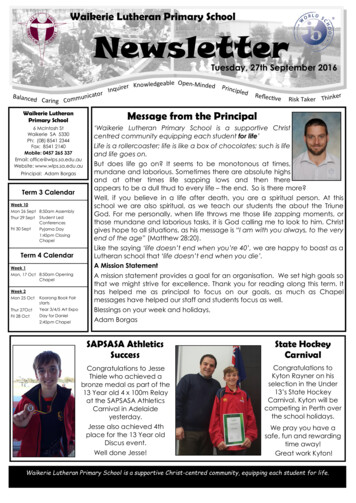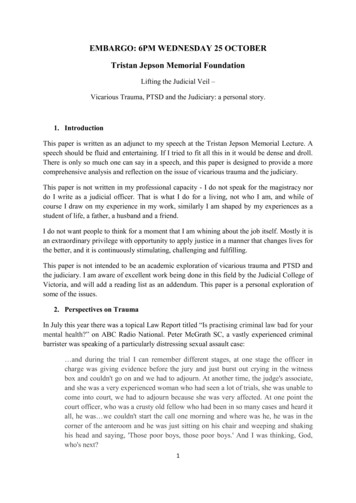
Transcription
EMBARGO: 6PM WEDNESDAY 25 OCTOBERTristan Jepson Memorial FoundationLifting the Judicial Veil –Vicarious Trauma, PTSD and the Judiciary: a personal story.1. IntroductionThis paper is written as an adjunct to my speech at the Tristan Jepson Memorial Lecture. Aspeech should be fluid and entertaining. If I tried to fit all this in it would be dense and droll.There is only so much one can say in a speech, and this paper is designed to provide a morecomprehensive analysis and reflection on the issue of vicarious trauma and the judiciary.This paper is not written in my professional capacity - I do not speak for the magistracy nordo I write as a judicial officer. That is what I do for a living, not who I am, and while ofcourse I draw on my experience in my work, similarly I am shaped by my experiences as astudent of life, a father, a husband and a friend.I do not want people to think for a moment that I am whining about the job itself. Mostly it isan extraordinary privilege with opportunity to apply justice in a manner that changes lives forthe better, and it is continuously stimulating, challenging and fulfilling.This paper is not intended to be an academic exploration of vicarious trauma and PTSD andthe judiciary. I am aware of excellent work being done in this field by the Judicial College ofVictoria, and will add a reading list as an addendum. This paper is a personal exploration ofsome of the issues.2. Perspectives on TraumaIn July this year there was a topical Law Report titled “Is practising criminal law bad for yourmental health?” on ABC Radio National. Peter McGrath SC, a vastly experienced criminalbarrister was speaking of a particularly distressing sexual assault case: and during the trial I can remember different stages, at one stage the officer incharge was giving evidence before the jury and just burst out crying in the witnessbox and couldn't go on and we had to adjourn. At another time, the judge's associate,and she was a very experienced woman who had seen a lot of trials, she was unable tocome into court, we had to adjourn because she was very affected. At one point thecourt officer, who was a crusty old fellow who had been in so many cases and heard itall, he was we couldn't start the call one morning and where was he, he was in thecorner of the anteroom and he was just sitting on his chair and weeping and shakinghis head and saying, 'Those poor boys, those poor boys.' And I was thinking, God,who's next?1
Of course there is someone missing from his description. The judge. What was he or shefeeling? How was the judge dealing with all this evidence that he or she was going to need torule on?3. Mental Conditions and the JudiciaryMuch has been written about ‘Judicial Stress’, including the seminal work by Michael Kirby.This is important work, however it seems to me that the term is really a euphemism for amental disorder. Just like people used to speak of a 'nervous breakdown' - as though yournerves had suddenly just stopped working due to some physical dysfunction. Now we call anervous breakdown for what it is - a mental health crisis. Similarly, whilst the early work inthis topic was useful and ground-breaking, we ought to stop talking of judicial stress, andstart calling it for what it is - anxiety, panic attack, insomnia, traumatic response, depression,PTSD, substance use disorder and the like.About one in five Australians will suffer from a mental health episode each year. One inseven Australians will suffer from depression in their lifetime, and an even greater numberwill suffer from an anxiety disorder. The rates are far higher amongst law students, solicitorsand barristers. According to the most recent research, 33% of solicitors and 20% of barristerssuffer disability and distress due to depression. They tend not to seek help and often selfmedicate with alcohol. Given that judicial officers are almost exclusively drawn from theranks of the profession, it would be a reasonable conclusion that a significant number ofjudicial officers suffer from debilitating mental health issues during their time on the bench.Reflecting on the line immediately above is important. This is a fairly revolutionary statementand debunks some myths about the judiciary. Of course we are meant to be above all this,unaffected by depression, trauma, anxiety, bi-polar disorder or alcoholism. Our objectivity, orwhat is left of it in a post-modernist world, must remain untouched by our own fragility.And if many will suffer from a mental health issue, then almost all the rest will suffer fromthe 'normal' stresses and strains of life caused by death of loved ones, divorce, conflict andphysical ailment. Unsurprisingly, judicial officers did not just spring from the womb to thebench and many have backgrounds as victims of crime, witnesses to domestic violence, andexperience of addiction or mental dysfunction. Judicial officers are just humans doing a job,and the sooner this becomes the accepted norm, the better the judiciary will be able to servethe community.And of course the mental health issues and stresses and strains of life affect work life. I don'tmean that we are necessarily unable to do our jobs, or even that we will do them badly, butwe may do it more slowly, or hesitantly, or arrogantly or grumpily at different times due tothose circumstances. This is not something to fear or turn away from - I'm sure the same istrue of surgeons, airline pilots, police and politicians too.There is a veil based on assumptions regarding judicial officers. The sooner that veil is lifted,the sooner judicial officers can admit to difficulties, access help and better serve the2
community. So, this paper is not primarily about helping judicial officers meander throughstruggles of life and work - it is the community’s interest that is my focus.4. My StoryI wish to preface this part of the paper by paying tribute to the others in the court process whosuffer direct trauma as a result of crime. First and foremost are the victims. Victims of sexualassault, domestic violence, robbery and the like suffer first hand trauma which is tragic anddeep. Seeing them bravely confront their tormentors and give evidence is a humblingexperience and I pay homage to them. Secondly, the first responders such as the police whohave to deal day in and day out with the violence, death and despair that they see oftenstruggle with trauma and I appreciate that their experience is much more direct andimmediate than from the perspective of the bench. Thirdly, I acknowledge the traumaencountered and experienced by the legal practitioners on both sides of the adversarialsystem. They often live, breathe and eat their cases, striving for justice by representing theaccused or crown.I have been a Magistrate for 18 years. I do not drink, and I am a committed meditator, yogapractitioner and I took my lay Buddhist vows a decade ago. Prior to that I was a criminallawyer and an academic. I represented those charged with child sexual assault, murder andserious domestic violence. I taught mainly criminal law and co-wrote a leading case book,that meant reading copious transcripts and judgments of a violent nature. I researched andpublished papers and a book on sexual assault of prisoners – primarily by interviewingvictims and perpetrators. I thought I had a pretty good 'distance' from my work, in the sensethat whilst it occasionally upset me, it did not stay with me too often in my personal life.About 12 years ago I was sitting in a series of cases involving child pornography in BatemansBay. In those days, it was necessary for the court to view the pictures and videos to determinethe seriousness of the charges – fortunately that is far less often today due to computerclassification. As is regularly the case, the charges included thousands and sometimes tens ofthousands of images and hundreds of videos. I will not re-traumatise all of us or re-victimisethe victims by describing the images except to repeat something that the Chief Magistratewrote in the case of Police v Power [2007] NSWLC 1 at 36:To see the pale death of innocence and trust in the eyes of so many young children isto bemoan the capacity for some members of the human race to descend into the darkand depraved side of the human condition.I dealt with over a dozen of these cases within a couple of months. I started dreaming of thesechildren and the torment perpetrated upon them. I would wake up in the witching hour3
screaming, sweating and panicked. I thought it would pass, but it did not. I was pretty scaredabout going to sleep, and that fear was well placed. I began thrashing around in my sleep,making it impossible for my wife to remain in bed with me for fear of getting struck. After aperiod of weeks of this, I sought professional help and was referred to a trauma psychologistwho engaged in some talk therapy by way of de-briefing. I also informed the ChiefMagistrate of my difficulties, and asked his permission to avoid such cases for a time. He wasextremely sympathetic and my colleagues from Nowra and Queanbeyan carried the load forthat time. The relief from the nightmares was immediate and dramatic. ‘Cured!’ I thought.I interpose to note that the help I received at that time was via the then newly formed JudicialAssistance Program in New South Wales. This program provides judicial officers and theirfamilies with confidential psychological counselling. The service was excellent then, andcontinues to this day.In the intervening years, and up to the present, my involvement in judicial educationincreased, and I became a lead trainer of new magistrates in Australia and the Pacific. One ofthe sessions I ran, and still run, is on mental health, and I would use my Batemans Bayexperience as a salutary lesson.Some 10 years later I had a bad six months on my current circuit. Over all of that time, I dealtwith a child sexual assault case which was later accurately described by the sentencing judgeas the "worst of the worst". She sentenced the father to 48 years imprisonment, and themother to 12 which is probably all I need to say about the horrors that were perpetrated onthis poor child. I had to deal with bail applications, contested interim apprehended violenceorders, committal hearings and subpoena issues all of which required reading and makingdeterminations on the evidence. My grandchildren had been born around that time, and Ithink I was in, as we on the north coast of NSW would say, a ‘heart opened’ state. I nowknow that empathy is a key determinate of vicarious trauma. I now know that empathy is nota static – it fluctuates with time. I think I was particularly empathetic at that time.During this period the Ice problem was escalating in my area, and there were four violentincidents inside the court, including a young addicted man who jumped out of the dock,fought his way out of the courtroom and jumped over the balcony at the front, breaking hisspine. I dealt with two juveniles from the far west of NSW who, having been bailed, that verynight held a toddler at knife point while they raped his mother, a nurse. And I dealt withanother horrible case of child pornography where I had to watch a video which involvedbinding, gagging, suspending upside down and violating a conscious two year old. Thatweek, a friend died in a freak surfing accident and at the funeral I was very messy. I was verynervous for my own and my family’s safety. I now see this as hyper-vigilance. I foundmaking hard decisions in court really painful. Actually physically painful - my head wouldhurt (just like Winnie the Pooh) when trying to decide whether to imprison someone, orrefuse them bail, or admit evidence. A good night’s sleep had become a distant memory. Iwould wake myself up screaming.4
My family and friends had been concerned about me for some time. They were encouragingme to take some time off work and to seek help. I stubbornly refused.In retrospect of course this stubbornness was completely unreasonable. I would like to try toexplain it though without excusing it. Firstly, my reaction seemed so pathetic in comparisonto the victims. I kept thinking what a wuss I was. I saw victims work their way out ofpsychiatric care and through university with flying colours, the calm determination ofdomestic violence victims and the shaking voices of police officers in coronial matters and Iwas thinking that my reactions were just so much ‘weak little me me me’. Second-handtrauma just seemed so, well, second-hand. Secondly, up to that point, in my entire workinglife I had rarely had a single sick day. This was a question of pride and I saw it as part of myreputation as a reliable, dependable rural magistrate. After all, if the magistrate gets sick atshort notice literally hundreds can be inconvenienced, hearings that have been waiting withdefendants in custody and witnesses from interstate may have to wait another six months. Ithink that one of the symptoms of trauma is catastrophisation, and another is an inflated senseof irreplaceability. Thirdly there were the usual reasons people don't want to admit to mentalfragility, especially men.After probably three months of bleakness I took the ‘advice’ of my GP and took a couple ofweeks off. Advice is in inverted commas because she was utterly insistant. I wrote a letter tothe Deputy Chief Magistrate responsible for leave, and spilt the beans on my state of mind.She was a friend and colleague of many years standing and to this day I cannot believe howhard this letter was to write. It was achingly difficult, and I can honestly say it was the hardestletter I have written in my life. Crazy but true.Being a practitioner of Buddhism I went on retreat with a long term teacher at Chenrezig onthe Sunshine Coast. This was an ice breaker and over the period of the next few months Iprogressively improved. I do not wish to be proscriptive on treatment, as I'm sure differentprocesses work for different people. I started with talk-based therapy (good, but sometimesre-traumatising), tried medication (a nice mental holiday, but didn't last) and then EMDR(Eye Movement Desensitisation Reprocessing) which was brilliant. If someone had once toldme that wiggling fingers in front of eyes could actually work I would have laughed out loud. Ido not mean to belittle EMDR. It has truly been a wonderfully successful treatment for me. Idid nine sessions with a terrifically skilled psychologist, and from the outset felt a lifting ofanguish.During this time support of my colleagues and the Chief and Deputy Chief Magistrates wasmagnificent. Calls, emails, check-ins were almost but not quite overwhelming. I am fortunateindeed that the NSW bench is collegiate and supportive. This is no accidental development.As the Chief Magistrate has often commented – the strength of the bench, in the end, comesdown to the health of the people who sit on it.Apart from the two weeks at Chenrezig and normal leave I have been back at work whilegetting better. I approach my ability to cope with traumatic cases with a mixture ofconfidence and trepidation. Did it affect my ability to competently do my job during my5
darkest days? It is difficult to tell. Certainly, there was no rash of appeals from my decisionsor criticisms by higher courts. There were no complaints to the Judicial Commission. Iprobably consulted more with my colleagues on harder cases to check I was on the right path,and perhaps I was gruffer than usual with lawyers who I perceived as incompetent or worse.I now view my mind as a big sponge when dealing with traumatic cases. It sucks up some ofthat trauma vicariously, and I am watchful to ensure that the sponge does not get too full. Iwould not hesitate to seek help should the sponge feel close to full, and I am certainly betterplaced to watch for the signs given my experience.It is certainly not my intention to become some sort of poster boy for vicarious trauma orPTSD and the judiciary. Nor can I remain silent. I am convinced that it is time to lift the veilfor the benefit of the judiciary, but also for the system of justice itself. The community is bestserved by recognising and acknowledging this issue, rather than hiding it.5. Random ReflectionsHaving given this some issue some thought over the last few years it seems that there aresome issues that require addressing.TechnologyObviously, the key causation issue is exposure to trauma. For country magistrates the sheervolume of traumatic work is hard for those outside the criminal justice system tocomprehend. We are also coroners, and I will often spend my lunch time running throughgruesome evidence and reading suicide notes. Responses to trauma for judicial officers areoften cumulative and exponential.Modern technology has made the trauma much more ‘in your face’. I can read a violent scenein a book and be unaffected, but a movie is far more challenging. Real violence is nowcaptured on CCTV, smart phones, in-car-videos and DVEC’s. When I started in this job,some form of graphic video or photographic evidence was a rarity. Now there are few caseswithout it. I have put in place protocols to protect myself and my staff as much as possible.Our coronial files have the on-scene photographs in a sealed envelope. The reality is thataccessing them is rarely necessary. I resist observing child pornography videos, and havingthem played in open court is a very last resort. Similarly, once tendered, photographs ofwounds are sealed to avoid accidental exposure.The Intimacy of the Decision MakerIn our court there is no jury, and so we alone must determine guilt or innocence, largelybased on the evidence of the victim and the defendant. That means we have to assess thetruthfulness of the witnesses very carefully. This involves, to some extent, ‘getting inside thehead’ of both. Often that is a very frightening place. Did the victim really get touched likethat? Did the defendant really believe the victim was consenting? Is the inconsistency of the6
victim’s first complaint and evidence today suggestive of fabrication? Is a person of such finecharacter really likely to have done such an abhorrent thing?These are tough questions to answer, and for a conscientious judicial officer requires adetermined focus and concentration. My hypothesis is that this level of absorption makesvicarious trauma unsurprising. We cannot just listen dispassionately to the evidence; we haveto digest and ruminate on each morsel and literally judge the people before us. This is a levelof intimacy, for want of a better word that perhaps fills the sponge more rapidly than onewould expect.Decision FatigueThe relationship between decision fatigue and vicarious trauma is, as far as I can tell,completely un-researched. However, in my view there is a fair chance that each exponentiallyaffects the other. In the Local Court, on my current circuit I have four list days per week.Most of those involve in excess of 100 cases. On average I will have over 15 people incustody, and deal with around eight bail applications every list day. I will have fifteen totwenty coronial matters on the boil inevitably involving gore and grief. Some days I willcome home and be asked some innocuous question involving choice - what would you like toeat for example - and I will respond that if I have to make one more decision I will actuallyjust dissolve or burst. This pressure, felt at all levels of the judiciary to some extent or other,is I suggest poisonous to maintaining a vicarious trauma shield.Emotion Bad/Intellect Good1Throughout our education, our practice and our role as a judicial officer we are taught tosupress our emotions in a quest for apparent objectivity. It is perhaps time to recognise thatthe expression of emotion is not the opposite of administering justice. I have laughed on thebench, and I have teared up on the bench. This is neither good nor bad. It just is, and part ofrecognising that judicial officers are humans not automatons. I have learnt that supressemotion every day is a recipe for mental health fragility.Statutory Barriers to DisclosureOne great fear of Judicial Officers is that if they have a mental health issue of some sort orother they could lose their appointment. In New South Wales, there is a process establishedunder Part 6A of the Judicial Officers Act 1986 which indeed could lead to this result. Inessence, pursuant to s39G(1), the Conduct Division must assess if the judicial officer is"physically or mentally unfit to exercise efficiently the functions of a judicial office"1I am grateful to Justice Jennifer Coate for this heading.7
If so, the Conduct Division is to present a report to the Governor. This in summary meansthat there is a parliamentary vote of both Houses to determine dismissal. In reality, those withmental health issues have nothing to fear if my experience is anything to go by. I am aware ofothers of my colleagues who have suffered mental health issues, and returned to work aftermonths without any suggestion of referral to the Judicial Commission.Community AcceptanceIn New South Wales, two magistrates in the last decade survived a parliamentary vote afterthe Conduct Division referred the matters for misconduct in office. Both magistrates madereferences to mental health issues in their address to parliament. One had undiagnosed bipolar disorder, and the other explained her conduct in part by reference to a change in herdepression medication. I have carefully reviewed the media surrounding these referrals. Thecommentary and discussions showed a degree of acceptance of their mental conditions, andthere was no outcry at the decision to permit them to continue on as magistrates despite this.In my view, this is indicative of a level of acceptance that judicial officers are indeed meremortals, and that even those with significant mental health conditions ought be able tocontinue their work as judicial officers after being properly treated.In Victoria, the Judicial College has established its Judicial Wellbeing program andassociated research, which frankly and controversially addresses issues relating to judicialofficers and mental health. In 2012, Justice Marshall of the Federal Court of Australiapublically acknowledged his personal struggle with depression, again with little fanfare orcontroversy.Politicians have long since broken through perceived barriers with John Brogden, AndrewRobb, Scott Ludlam and Geoff Gallop all disclosing mental health issues with a high degreeof bipartisan acceptance.SecuritySecurity threats are inherently traumatic experiences, and like many judicial officers I havehad a significant number over the years. I had a makeshift bomb put on a gas tank at a courtrelated to a family court matter, the KKK graffiti my house, specific death threats thatresulted in 24 hour surveillance and presently there is a person in custody charged withallegations relating to a contract killing. These threats pose a real danger to the mental healthof judicial officers for obvious reasons, and it is difficult to separate hyper-vigilance fromrealistic precautions at times.Loneliness of the JobI have worked in both the city and the country, and the job can feel exceptionally lonelydespite the collegiate nature of the bench. There are real limits on your social life, and inparticular the mates and friends from the legal profession are likely to give you somedistance. Many judicial officers work in single courts and are away from loved ones for days8
or weeks at a time. There is little opportunity for the kind of informal talk therapy ordebriefing that can empty the sponge in that scenario.In discussing the tragic fall from grace of former Attorney General and Supreme CourtJustice Jeff Shaw QC, then Chief Justice James Spigelman wrote:“There is a loneliness about it and that’s what really got to Jeff. He started drinkingalone. It was a huge personal tragedy and I actually attribute it to the loneliness ofbeing a judge. He had a predilection and the loneliness of the job tilted him into thisworld that he couldn’t escape from”6. The Need for Research:Clearly there needs to be more research into mental health issues and the judiciary. There hasbeen some limited and now out-dated research on vicarious trauma and PTSD in judges in theUnited States.In the first study in 2003, 105 Family and Juvenile Court judges from across the USA weresurveyed. The majority of judges (63%) reported one or more symptoms of work relatedvicarious trauma. Most at risk were female judges, and those of seven or more years ofexperience. In the second study in 2009, nine judges underwent detailed assessment and theresearchers found that all were at risk of secondary trauma and most displayed symptoms. Asimilar result was found in Immigration Judges.Similar research obviously needs to be undertaken in Australia. Particular focus could be onthe following issues: What are the current rates of vicarious trauma/PTSD in Australian judicialofficers? I see no reason why it would be any lower than in the USA. When does the issue become more acute? After 5 -10 years on the bench? Theresearch would suggest that this would be likely. Is there a relationship between judicial officers sitting alone and in countrycourts and increased levels of PTSD. I suspect so. My father sits on the MentalHealth Review Tribunal and he often comments on the joy of having tribunalmembers to bounce issues off. In England, there are usually two or threeMagistrates making decisions. Comparative research would be useful. What percentage of disciplinary matters involving judicial officers have anunderlying mental health issue. For lawyers it is reportedly 80 %. Is there evidence to support the hypothesis that an annual ‘mental health’check-up for judicial officers would be of assistance? Does opting out of certain types of cases for a time help? It certainly did forme.9
What are the most effective methods of increasing resilience – mentoring,education, buddying, debriefing, supervision?7. ConclusionI am grateful for the support of the Tristan Jepson Foundation for facilitating this paper. Thisis an organisation of extraordinary import, and I pay tribute to its founders and board. It isclear that the guidelines promulgated by the Foundation and adopted by some courts, ought tobe embraced by all courts. In my view, the bench should lead by example in the area ofmental health. We are blessed by incumbency, security of tenure and status absent for manyin the private profession, and those benefits should provide a firm basis for making a saferworkplace.This paper is not intended to be a final word on these issues. I hope that it engenders debate,and that my personal experience is useful in formulating approaches in protecting the law’smost precious assets – its people.10
Reading ListBOOKSHeilpern, David M, Fear or favour: Sexual Assault of Young Prisoners (Southern Cross UniversityPress, 1st ed, 1998)Milne, A.A, The World of Christopher Robin (Methuen & Co Ltd, 2nd ed, 1960)JOURNALSAnleu, Sharyn Roach, Kathy Mack and Jordan Tutton, ‘Judicial Humour in the Australian Courtroom’[2014] 24 Melbourne University Law ReviewEels, T.D, C.R Showalter, ‘Work-Related Stress in American Trial Judges’ (1994) 22 Bulletin of theAmerican Academy of Psychiatry and the LawHampel, Felicity, ‘From Stress to resilience’ (2015) 89 (9) Law Institute Journal 33Queensland Law Society, ‘Best Practice Guidelines for the Legal Profession’ (2016) Tristan JepsomMemorial Foundation: Psychological WellbeingSchrever, Carly, ‘Judging Stress’ Law Institute of Victoria (2015) 89(9) Law Institute Journal 33Zimmerman, I.M, ‘Isolation in the Judicial Career’ (2000) 36(4) Court ReviewZimmerman, I.M, ‘Helping judges in distress’ (July- August 2006) 90(1) JudicatureCASESPolice v Power [2007] NSWLC 1LEGISLATIONJudicial Officers Act 1986 (NSW)OTHERAustralian Bureau of Statistics, Mental Health Statistics, 2015, Catalogue No. 4330.0 Canberra: .0Brooke, Henry, ‘Judges and vicarious es-and-vicarious-trauma/11
EMDR Institute Inc, Eye Movement Desensitisation and Reprocessing, Providing an EffectiveTherapy for the Treatment of Traumahttp://www.emdr.com/Judicial College of Victoria Judicial Wellbeing Literature l-wellbeing/judicial-stress/literatureGibson J and Snow D ‘My brother judge’s tragic fate: Chief Justice speaks out’ SydneyMorning Herald, 18 October 2010Kirby, Michael, ‘Judicial Stress’ (Speech delivered at the Annual Conference of the Local Courts ofNSW, Law and Justice foundation of NSW, 2 June 1995)http://www.lawfoundation.net.au/ljf/app/&id E812A4B4C60E3A26CA2571A8002344A5Kirby, Michael, ‘Lawyers’ Suicide- The Influence of Legal Studies and Practice, Stress, ClinicalDepression and Sexuality’ (Speech delivered at the launch of the Daniel Solomons MemorialScholarship, Ashurst Lawyers, UNSW Law, Sydney, 20 April 2015) 38(4) University of New SouthWales Law JournalLaw Society of NSW, Mental Health Statistics and Seeking rs/MentalHealth/Statistics/index.htmLee, Jane, ‘Judge tells of depression struggle in bid to help many in legal circles’, The Age (online),14 September 2013 cles-20130913-2tqci.htmlLustic SL et al ‘Inside the Judges Chambers: narrative responses from the National Association ofImmigration Judges stress and burnout survey’ Georgetown Immigration Law Journal , 23 Geo.Immigr. L.J. 57Marshall, Shane R, ‘Depression: An issue in the study of law’ (Keynote address delivered at theNational Wellness for Law Forum, Australian National University College of Law, February 2015)Queensland Government, Mental Health Review Tribunal (2010) https://www.mhrt.qld.gov.au/Tristan Jepson Memorial Foundation Resources
serious domestic violence. I taught mainly criminal law and co-wrote a leading case book, that meant reading copious transcripts and judgments of a violent nature. I researched and published papers and a book on sexual assault of prisoners - primarily by interviewing victims and perpetrators.

